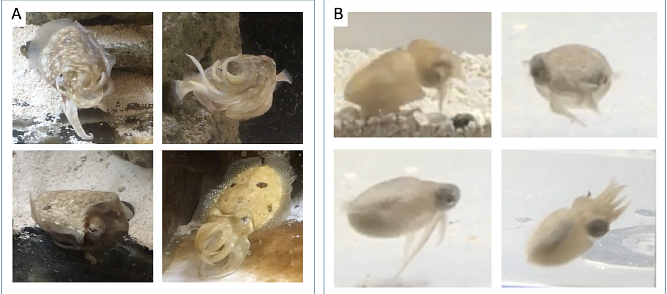Cuttlefish interaction with multimodal arm wave signs displays

Cuttlefish interaction with multimodal arm wave signs displays
Cohen Bodenes, S.; Neri, P.
AbstractIn addition to the well-known extraordinary changes in visual appearance they can generate at the level of their mantle, cuttlefish can produce various body configurations combining chromatic, postural, and locomotion patterns, both for camouflaging and communication. We introduce a previously undescribed communication display in two cuttlefish species: Sepia officinalis and Sepia bandensis. The four \"arm wave signs\" are stereotyped arm movements consisting of long-lasting, expressive, and repeated sequences of undulations of the arms, which can be combined and expressed following specific patterns. Using non-invasive behavioral experiments, we tested the hypothesis that they represent multimodal communication displays. To assess the role of visual cues, we recorded videos of animals signing and played them back to individual cuttlefish participants. When seeing the movies, cuttlefish waved back at the display. Most importantly, they were more likely to wave back when the movie was in upright (original) configuration as opposed to flipped upside-down, similar to the manner in which humans perceive faces and other socially relevant displays. In addition to their visually striking display, arm wave signs produce mechanical waves in the water, prompting us to explore the possibility that they may also be perceived via mechanoreception. Using playback experiments similar to those adopted in vision, we obtained preliminary evidence to support this hypothesis, indicating that arm wave signs may represent multimodal signals involving vision and mechanoreception. Our new result on communication with arm wave signs opens up novel possibilities for understanding vibration-mediated communication through the lateral line and/or the statocysts in a cephalopod species as an example of convergent evolution with vertebrates.